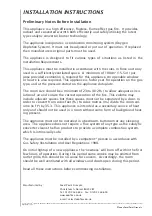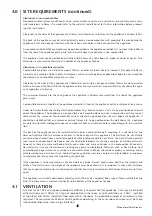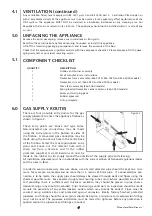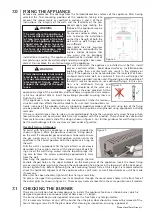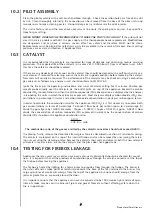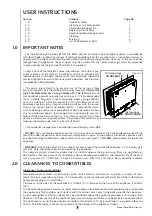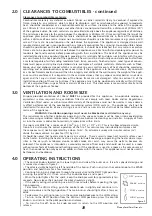
TESTING AND COMMISSIONING
Turn on and test the gas supply up to the fire for any leaks, in accordance with the current edition of BS
6891 (natural gas installations) or the current edition of BS 5482 pt1 (propane installations).
For Republic of Ireland, reference should be made to the current edition of IS813 (the relevant standards
governing installation).
OPERATING THE APPLIANCE
The pilot is visible behind the left hand side of the burner.
The control knob is located on the lower right hand side of the
outer case. It is of a spherical design and is marked as shown in
figure 6;
Push in and turn the control knob to the SPARK position, and hold
there for a few seconds. Continue turning anti-clockwise through
the spark click to the PILOT light position, ensuring the pilot has
lit. If not, return the knob clockwise, and repeat.
When the pilot lights after the spark, keep the knob depressed for
approximately ten seconds. Now release the knob and the pilot
should stay alight. If the pilot is extinguished during use, wait
three minutes before repeating the ignition procedure.
To achieve the HIGH setting, push the control knob in slightly and continue turning anti-clockwise to the
high position. The main burner should light after a few seconds. To decrease the setting to LOW, turn the
control knob clockwise to the low setting.
To turn to the PILOT position from the HIGH or LOW positions, press the control knob in, and return to the
pilot position and release. To turn the fire OFF, keep the knob pressed in, return to the off position and
release.
SPARK FAILURE
The gap between the spark electrode and the pilot should be 3 - 5mm to produce a good spark. There
should be no need to adjust this. If under any circumstances the piezo electric spark fails, the pilot cannot
be lit manually.
SETTING PRESSURE
The pressure test point is located on the left hand side of the appliance, on the main burner pipe, next to
the brass restrictor/connector. Release the setting pressure test point screw, and attach a pressure gauge.
Light the fire on the HIGH setting.
To commission the appliance, the burner pressure must be in accordance with the figures stated in the data
section of these instructions.
The fire is factory set to achieve these pressures and
any significant variation could indicate a supply prob-
lem. If the pressure is too high, the gas supply meter
/regulator may be set incorrectly. This should be
checked with the fire running and if necessary reset by
the gas supplier.
If the burner pressure is too low, then check the inlet
pressure with the appliance running. If this is less
than than the figure stated in section 2.0 of these
instructions it will need to be reset by the gas suppli-
er. If the setting pressure is too low, but the meter
pressure is acceptable, then a problem in the supply
pipework is to be suspected.
This will be dirt and debris, kinked or inadequate size pipes, restriction in a fitting, shut off elbow not fully
open or solder flashing across a joint. Identify the cause of the restriction and rectify. Switch the fire off,
disconnect the pressure gauge and refit the test nipple screw. Light the fire and check for gas soundness.
In the event that the burner pressure is not in accordance with the figures stated in the data section of these
instructions, the appliance must not be commissioned, and the manufacturer should be contacted for guid-
ance.
6
8.3
8.0
8.1
8.2
‘OFF’ position
‘SPARK’ position
‘LOW’ position
‘HIGH’ position
©
2009 Focal Point Fires plc.
Figure 6
Figure 7



